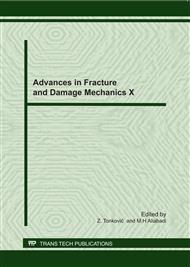p.464
p.468
p.472
p.476
p.480
p.484
p.490
p.494
p.498
An Effect of Shot Peening on Retardation and Growth of Short Fatigue Cracks in an Aircraft Al-Alloy
Abstract:
The paper contains the main results of an investigation of an effect of shot peening on residual fatigue life of specimens made of an aircraft V-95 Al-alloy (equivalent to 7075 alloy) containing physically short fatigue cracks. In the first part, an adaptation and verification of direct current potential drop method for detection and measurement of short crack growth is described and discussed. The specific properties of the material and quite large dimensions of flat specimens with side necking with a low stress concentration factor had to be considered when the position of electrodes was specified. The specimen type and dimensions were proposed considering the investigation of shot peening effects. Physically short fatigue cracks of the length from 0.2 mm to more than 3 mm, most of them between 0.8 – 1.5 mm, were prepared under high cycle fatigue loading of the constant nominal stress amplitude ±160 MPa. Specimens with existing short fatigue cracks were shot peened using two different groups of parameters. Crack growth characteristics after shot peening were measured and compared with crack growth in specimens without shot peening. Retardation of crack growth was significant particularly for cracks shorter than 2 mm. Results are also discussed form the viewpoint of fracture mechanics approach. For the specific stress amplitude, evaluated results enable to estimate threshold length of defects, which after the application of shot peening will be reliably arrested.
Info:
Periodical:
Pages:
480-483
Citation:
Online since:
September 2011
Authors:
Price:
Сopyright:
© 2012 Trans Tech Publications Ltd. All Rights Reserved
Share:
Citation:


